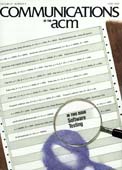Tablet: personal computer of the year 2000
A design represents a compromise between conflicting goals, and the design of the personal computer of the year 2000 is no exception. We seek something that will fit comfortably into people's lives while dramatically changing them. This may appear to be a contradiction that cannot be reconciled. But if the technology does not fit easily into the habits and lifestyles of its human users, it will be discarded by those it was meant to help. And if this new tool does not change the life of its owner, it is only because we have been too shortsighted to imagine the possibilities.
Our way out of this dilemma is to base the design upon something which is already integrated into everyone's life, to take a vital tool and give it more life. We have chosen to improve something that most people use everyday, the humble paper notebook.
We have all heard the computer revolution was supposed to eliminate paper from the workplace. Instead, it has lead to desktop publishing; now we can not only write papers but typeset them ourselves. Paper notebooks have many properties that make them particularly friendly. They are light and portable. No one thinks twice about taking a pad anywhere. They are easy and natural to use, as accessible to the toddler as to the octogenarian and as relevant to the artist as the engineer. They can be used to communicate with other people. They are the ideal medium for integrating text and graphics, and perfect for creative doodling. Moreover, notebooks are forgiving of mistakes, simply peel off the page and start anew.
It is natural to revise and edit written documents. There is something satisfying about crossing out an offending sentence from a written draft, a feeling that word processors have not captured. We aim for a computer that will provide all of these benefits and more.
Thus, the personal computer of the year 2000 will be a portable machine the size of a notebook. We will write and draw with a stylus on a screen which mimics a physical writing surface. Enhancing this with the powers of computation and communication, we create a tool that will improve the way we live and work.
This report provides a more concrete depiction of the machine we have in mind, namely TABLET.




